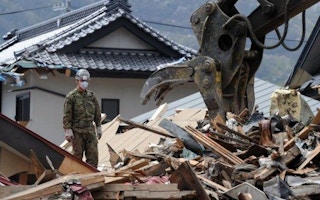Plans are under way to build electric power plants in Fukushima Prefecture that draw on new energy resources, to replace the nuclear power generation that has supported the regional economy.
In Minami-Soma, Fukushima Prefecture, efforts are under way to build a solar power plant in rice paddies. The project is led by Eiju Hangai, a native of the city and a former employee of Tokyo Electric Power Co.
“I caused trouble for my home prefecture. I want to transform the Hamadori region into a place of renewable energy sources,” Hangai said.
Hangai, 58, was an executive officer at TEPCO, in charge of such operations as refurbishing condominiums and nursing care services. He left the company in June 2010.
His parents’ home is inside the no-entry zone around TEPCO’s crippled Fukushima No. 1 nuclear power plant, and his 78-year-old mother, Kumi, now lives with his younger sister in Tokyo.
After the Great East Japan Earthquake, Hangai drove a two-tonne truck from his home in Tokyo and transported aid goods, such as winter clothes, to a gym in Minami-Soma.
At the gym, a female evacuee told him with an icy gaze: “TEPCO did a terrible thing. I worry about the future of children here.”
With mixed feelings of being both a victim and also a perpetrator, Hangai established the Fukushima Fukko Solar company in September. It plans to set up solar power generation panels with output capacity of 500 kilowatts and sell the electric power to Tohoku Electric Power and other firms.
The company is likely to secure 200 million yen through other companies’ financial cooperation and government subsidies, and plans to start operations in spring next year.
There is a also plan to build huge wind power generators in the sea several kilometers off the Fukushima nuclear power plant.
University of Tokyo Prof Takeshi Ishihara is conducting a study with 10 Japanese and foreign companies, including Marubeni, the university and the Economy, Trade and Industry Ministry, in a joint project by the public sector, private companies and academic circles.
The plan calls for setting up wind turbines that are 200 meters tall—as tall as skyscrapers—on shiplike floating bases at sea. The floating bases will be anchored to the seabed.
Participants plan to build about 140 of the power generators and produce a total of 1 million kilowatts—equivalent to that of a nuclear reactor—by about fiscal 2020.
If realized, it is estimated the project and related works, such as the production of parts, will create about 5,000 jobs.
Use of new energy resources is also expected to resolve the problem of the massive amount of debris that together with the nuclear disaster has hindered reconstruction work.
Makoto Suzuki, 51, runs a biomass power generation plant in Murayama, Yamagata Prefecture. He has accepted wooden debris from the disaster-struck Sanriku region and used it to fuel power generation since July.
For fuel, biomass power generation uses wood, leftover agricultural products, livestock excretions and other materials stemming from animals, or gas made from these materials.
Wooden biomass can effectively utilize timber from forest thinning and scrap wood, and the resources can be recycled repeatedly by growing new plants.
Usually, the plant uses branches cut from cherry trees during harvesting as fuel.
Suzuki visited a sports ground in Kesennuma, Miyagi Prefecture, a month after the disaster and saw piles of debris there about 10 meters high. The debris contained scrap wood from destroyed houses, metal, vinyl, and stone. He felt it would be impossible for the afflicted communities to dispose of all of the debris on their own.
Burning the debris in the power generators carries the risk of radioactive substances.
Suzuki has measured radiation levels each time he burns debris. He and the Murayama city government cooperated in explaining to local residents that the radiation levels of the debris were not higher than those in wood collected inside Yamagata Prefecture.
After explaining repeatedly, Suzuki finally was able to use the debris as fuel.
“I’ll continue to accept [debris] until the disaster-hit areas are cleared,” he said.
Unlike nuclear power generation, it is difficult for new energy resources to cover most electricity demand. But various attempts are under way in many disaster-hit locations, aimed at creating industries and jobs.










